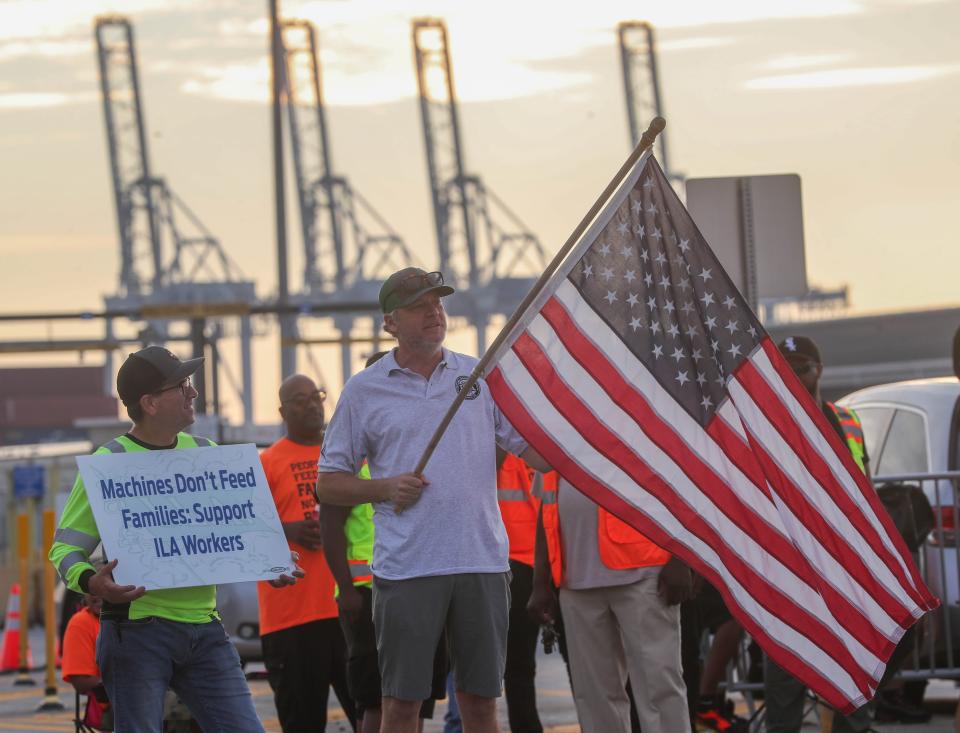Members of the International Longshoremen’s Association (ILA), representing tens of thousands of workers across the Atlantic and Gulf coasts, went on strike at 12:01 a.m. on Oct. 1. The strike followed the union’s rejection of a final proposal from the United States Maritime Alliance (USMX) on Monday. The offer fell short of ILA demands for higher wages and protections against automation.
“USMX triggered this strike by siding with foreign-owned ocean carriers that earn billions in profit at U.S. ports but refuse to fairly compensate American longshore workers,” ILA president Harold Daggett said in a Facebook post Tuesday. “We’re prepared to stay on strike for as long as it takes to secure the wages and protections our members deserve.”
While 14 ports in the East and Gulf Coast are seeing striking workers, West Coast ports have not been affected as a different union represents its workers. Back in 2023, the West Coast union negotiated wage increases for its workers.
Why is the port strike happening?
One of the key reasons behind the current strike is the wage disparity between East Coast dockworkers and their West Coast counterparts. ILA workers earn significantly less. According to the contract that expired on Monday, ILA dockworkers started at $20 per hour, with pay rising to $24.75 after two years, $31.90 after three, and capping at $39 for those with at least six years on the job.

The ILA is now demanding a 77% wage increase over the duration of the new contract, with a $5 raise each year. Under their proposal, workers would earn $44 per hour in the first year, $49 in the second, and up to $69 by the final year. The U.S. Maritime Alliance offered a nearly 50% increase, which the ILA rejected.
“They might claim it’s a significant increase, but they ignore the fact that many of our members are operating multi-million-dollar container-handling equipment for just $20 an hour. In some states, the minimum wage is already $15,” the ILA said in a statement.
How much do dockworkers make?
While the current top wage is around $81,000 annually, a report by the Waterfront Commission of New York Harbor indicated that about a third of local longshoremen earned $200,000 or more last year. However, the high earnings often come with grueling hours. ILA president Harold Daggett told the Associated Press that many workers logging such high pay work up to 100 hours a week.
“Our members don’t work typical 9-to-5 jobs; they work extraordinary hours, sacrificing time with their families. We stand firm in our belief in the value our incredible members bring to this industry and to our nation,” the ILA said.
The average U.S. salary in the fourth quarter of 2023 was about $59,000, according to the U.S. Bureau of Labor.
What items will be affected by port strike
Each day of the strike could cost the economy up to $5 billion a day as imports and exports are blocked, USA TODAY and Reuters reported. Big-name retailers, such as Walmart and Costco, have implemented backup plans heading into the holiday sales season, according to Reuters, bringing in Halloween and Christmas merchandise early to avoid any strike-related disruptions. However, it’s cost the companies extra to ship and store the products.
Here’s how imports and exports may be affected by the strike, according to USA TODAY:
-
Imports: With about half of U.S. ocean imports passing through the East and Gulf coast ports, a wide range of products are affected, including produce, cars, auto and machinery parts, clothing, pharmaceuticals, wine and spirits, holiday goods like toys, and seafood, experts said.
-
Exports: Businesses that sell products to international markets would suffer, experts said. For example, agricultural exporters of soybeans and poultry won’t be able to send their goods overseas and could end up losing market share, or worse, lose money because their goods are perishable, they said.
Which ports in NY and NJ are affected?
Six ports are closed in New York and New Jersey due to the ILA strike.
-
Howland Hook Marine Terminal in Staten Island
-
Red Hook Terminal in Brooklyn
-
APM Terminals – Port Elizabeth in Elizabeth, New Jersey
-
Port Newark Container Terminal in Newark, New Jersey
-
Maher Container Terminal in Elizabeth, New Jersey
-
Port Liberty Bayonne in Jersey City, New Jersey
In New York, the strike is not expected to impact petrochemical goods such as home heating oil, gasoline, and diesel, nor municipal solid waste at the Port of New York and New Jersey, according to Gov. Kathy Hochul on Monday. Cruise ships will also remain unaffected.
“New York has been working around the clock to ensure that our grocery stores and medical facilities have the essential products they need,” Hochul said on Tuesday.
There are currently nearly 100,000 containers at ports in the New York City area waiting to be unloaded, now stalled due to the strike. Additionally, 35 container ships are expected to arrive in New York in the coming week, Rick Cotton, executive director of the Port Authority of New York and New Jersey, told Reuters on Tuesday.
Upstate ports such as Albany, Coeymans, Oswego, and Buffalo are not expected to be affected, Hochul said.
Contributing: Reuters, USA Today Network
This article originally appeared on Rockland/Westchester Journal News: Port strike puts wages in spotlight. How much do port workers make?
Source Agencies


